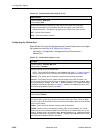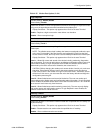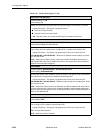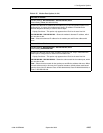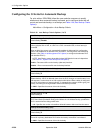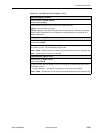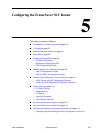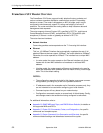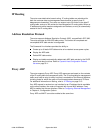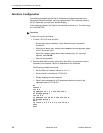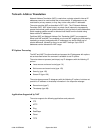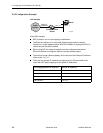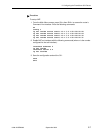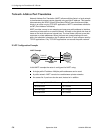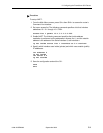
5. Configuring the FrameSaver SLV Router
5-2
September 2002 9128-A2-GB20-80
FrameSaver SLV Router Overview
The FrameSaver SLV Router supports locally attached hosts or subnets and
various customer premises distribution networks that contain IP forwarding
devices or routers. The router is shipped as an 802.1d bridge, and it can be
configured to simultaneously support IP routing and bridging of all non-IP
protocols. The router maintains two routing tables to keep customer data and
management data separate.
The router supports Internet Protocol (IP), specified in RFC 791, and Internet
Control Message Protocol (ICMP), as specified in RFCs 792 and 950 (with
exceptions). It acts as a router or gateway as defined in RFC 791.
The router has two interfaces:
Network Interface
Frame relay packets are transported over the T1 line using this interface.
Ethernet
This is a 10/100BaseT interface that automatically negotiates the rate. If all
attached Ethernet devices support 100BaseT, the router defaults to 100BaseT.
Otherwise, the router operates at 10BaseT. The interface has a unique MAC
address.
— In router mode, the router accepts on the Ethernet interface only those
frames with its own MAC address or a broadcast or multicast MAC
address.
— In bridge mode, the router accepts all frames and forwards only ones for
which the destination MAC address does not match an entry in the bridge
table. This is the default setting.
NOTES:
— The configuration examples included in this chapter cover some common
configurations, providing only a few of the possible scenarios.
— IP addresses used in the examples are for illustrative purposes only; they
are not intended to be used when configuring your local network.
— Command syntax will vary based on your network setup.
— Configuration commands require an access level of Administrator-Config,
and changes need to be saved when being configured to take effect.
For additional information, refer to:
Appendix B,
SNMP MIBs and Traps, and RMON Alarm Defaults
, for details on
the supported MIBs and RFCs.
Appendix C,
Router CLI Commands, Codes, and Designations,
for specific
commands and complete syntax.
Appendix D,
Router Command Line Summaries and Shortcuts
, for specific
command default settings and abbreviated command line syntax.



